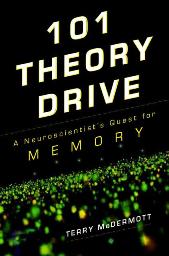
101 Theory Drive: A Neuroscientist’s Quest for Memory
by Terry McDermott
–Reviewed by Shahnaz Habib
 Under Terry McDermott’s watchful, and sometimes worshipful eye, his subject – UC Irvine neuroscientist Gary Lynch – emerges as a charming egomaniac and autodidact, an engrossing character. But more importantly, 101 Theory Drive offers an education in how science happens – the almost exploitative systems of work, the incestuously small and competitive community of scientists, the personal stakes involved in turning a hypothesis into a theory.
Under Terry McDermott’s watchful, and sometimes worshipful eye, his subject – UC Irvine neuroscientist Gary Lynch – emerges as a charming egomaniac and autodidact, an engrossing character. But more importantly, 101 Theory Drive offers an education in how science happens – the almost exploitative systems of work, the incestuously small and competitive community of scientists, the personal stakes involved in turning a hypothesis into a theory.
Lynch is by training a psychologist. He taught himself neuroanatomy and cell biology after turning away from behavioral psychology, and has spent decades researching how memory works. Lynch has hypothesized that the formation of a new memory causes a structural change in brain cells through a process known as long-term-potentiation, or LTP. McDermott catches him in an intimate profile as he struggles to convince the scientific community of this hypothesis.
One of the joys of reading 101 Theory Drive is accompanying McDermott on his learning curve – which is almost as impressive as Lynch’s. The book is dense with descriptions of neurological processes that McDermott goes to great lengths to translate for the lay reader. For instance, McDermott notes that many scientists think cells have to send new proteins to synapses to form memories. But that, McDermott says, summing up Lynch’s counter-theory, is akin to a construction crew having to “put down their hammers and call their office for a delivery every time they needed a nail.” In a later chapter, thinking about baseball players – who respond to pitches using their memory of the last throw – leads McDermott naturally to a broader discussion about human memory. We tend to file away experiences by relating them to what came before – in other words, we automatically categorize them during LTP.
Through such vivid comparisons, McDermott tantalizingly follows his mad scientist through rat decapitations, failed experiments, and the politics of peer-reviewed papers. Equally intriguing is the discussion of the medical and commercial implications of Lynch’s discoveries. Lynch founded Cortex, a company that develops high-impact ampakines that could provide a cure for various neurological disorders such as Alzheimer’s, Parkinson’s, and Attention Deficit Hyperactivity Disorder. Once frowned upon in the scientific community for mixing commerce with science, Lynch increasingly finds himself hailed for his entrepreneurship, particularly as public research money dries up.
Eventually, investigating the diseases leads Lynch to the next frontier: what Nobel Laureate Gerald Edelman refers to as “the remembered present” – consciousness itself. As McDermott puts it, “the brain is virtually always doing something. Signaling, initiated from the environment or internally, is constant.” And as Lynch himself hypothesizes, “All of this is mediated by changes in synaptic strength, across colossal chambers of networks…. Memory is the wrong word for all of this… it’s thinking.”
Lynch’s personal charisma and his epic quest to solve one of the most vexing biological mysteries of our times lends itself to mythologizing. McDermott presents him as a foulmouthed but conquering hero – the narrative breaks for conversations or email excerpts that only serve to prove Lynch’s alleged charms. And yet every Holy Grail needs a hero to search for it, and in Gary Lynch, the convoluted workings of human memory has found a knight errant. McDermott reminds us that there will always be more Holy Grails to find. There is no such thing as perfect knowledge in science, and it seems, there is no such thing as a perfect scientist.
Further reading: Big Brains: The Origins and Future of Human Intelligence by Gary Lynch and Richard Granger, and In Search of Memory: The Emergence of a New Science of Mind by Eric R. Kandel
*Photo above courtesy majorbonnet.




Send A Letter To the Editors